Tai Chi is Qigong. Qigong is not Tai Chi.
The difference? Tai Chi has martial art movements.
Qi is inherent in both.
Tai Chi is a soft, internal, defensive martial art, rooted in good body structure, producing the physics for good martial function.
Practitioners must “feel (and use) the energy” inside themselves, in addition to properly formed gestures, to set up the conditions to ward-off incoming force and use this force against the antagonist.
Most people will never “spar” (fight or train fighting skills) with another person. However, as the”Players” do the forms, Qi moves through the body via the meridians, and healthful benefits occur. Besides activating the “move it or lose it” principle, practitioners gain techniques for calm, focus, confidence, proprioception and stress reduction. Truly, the gifts are endless.
Below, you will find key images and ideas shared in our classes.
Tai Chi is much more than “going through the motions”. It is a way of life.
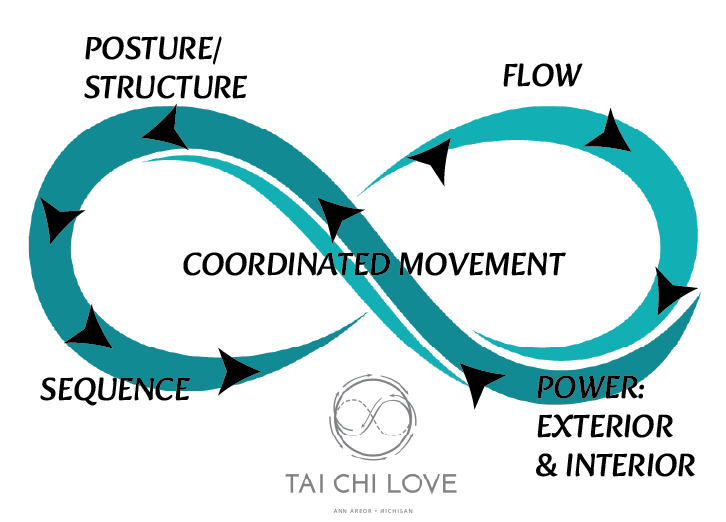
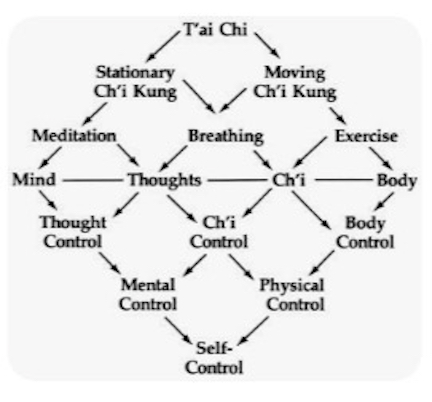
Symbol of the Tao
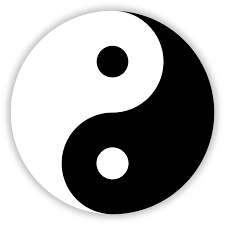
Character for the Tao or “The Way”
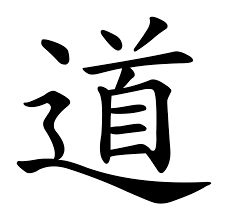
Human Energy Body & Qi (Energy) Radiations
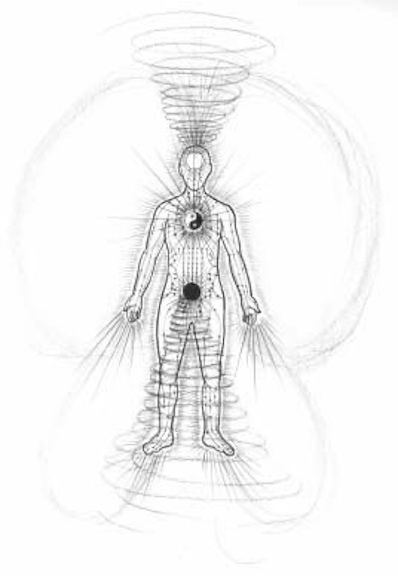
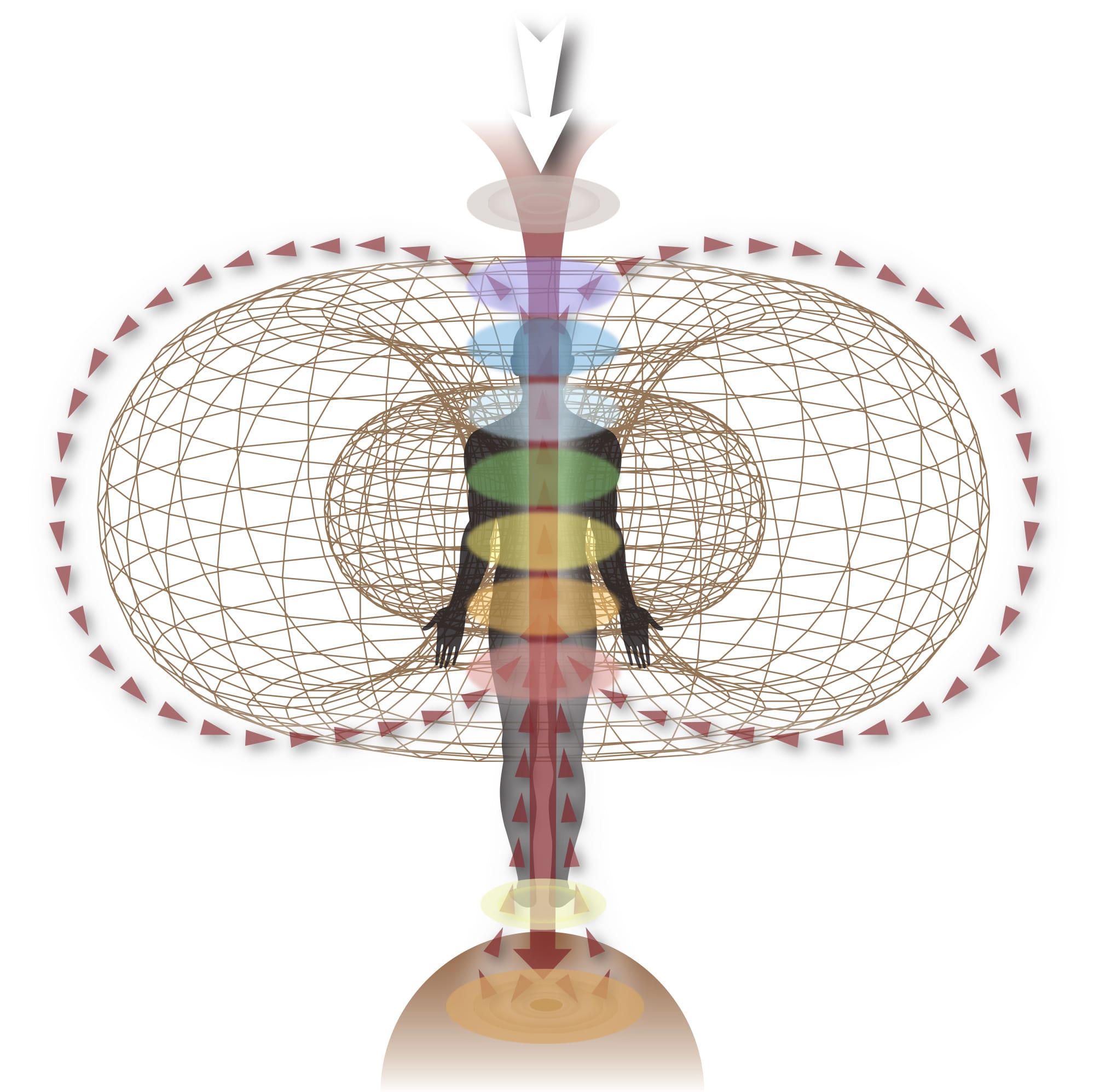
Character for Qi
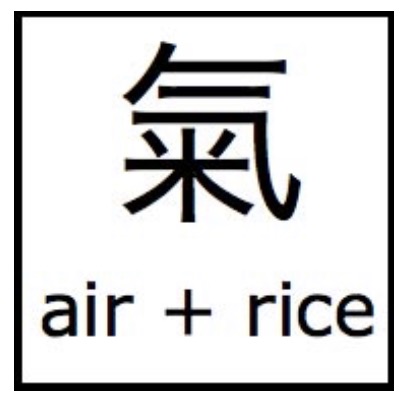
Modern Science Equation for the cultivation of Qi: glucose + 6O2 —-> 6H2O + 6C02 —> 686 Kcal
Microcosmic Orbit
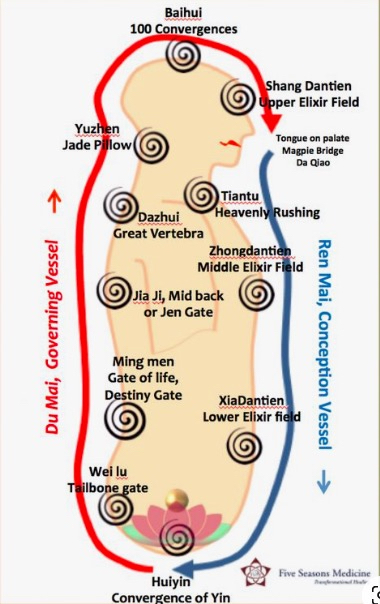
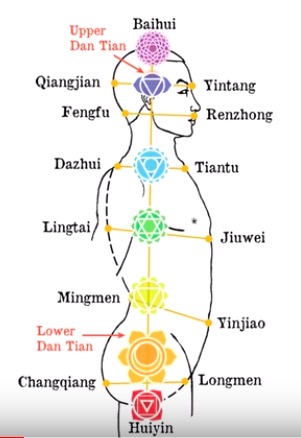
Qigong Charts of Correspondences
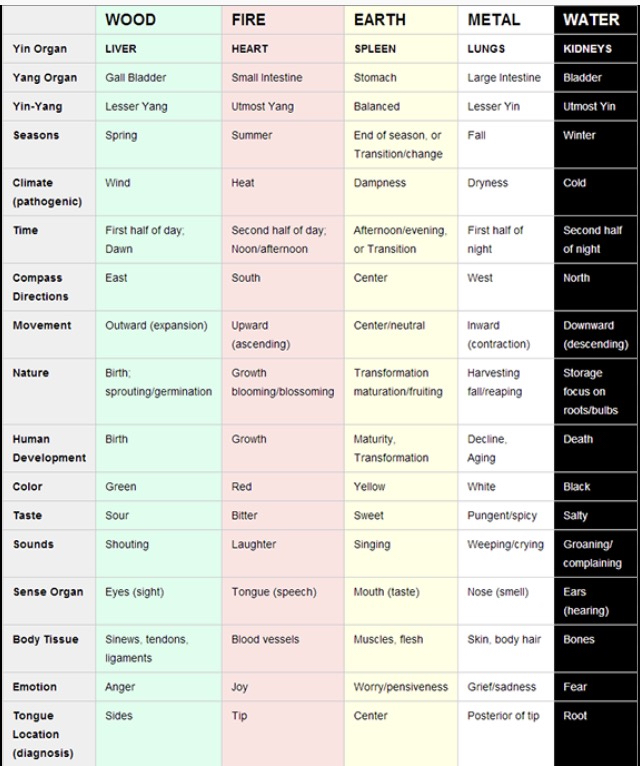
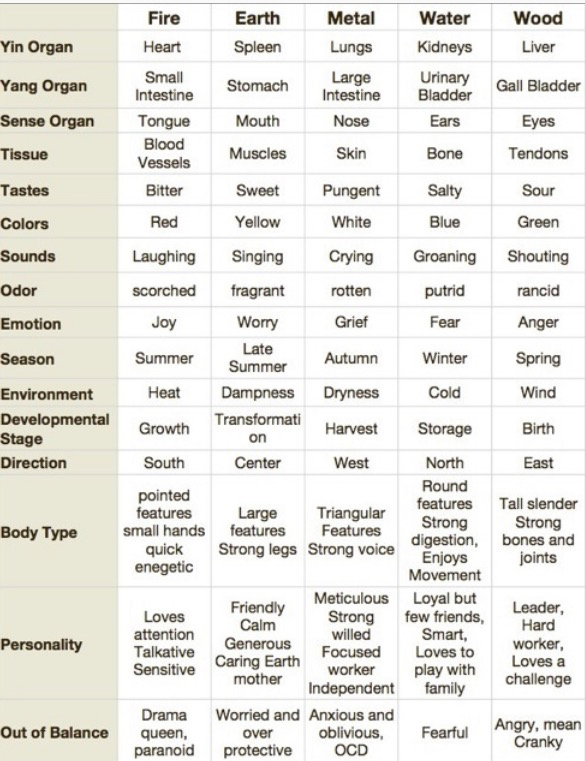
16-Point Meridian Activation of the Qi Jing Ba Mai (Eight Extraordinary Vessels)
 This is an advanced activation technique to exponentially raise your level of functioning, give you more energy, and align your body to your spiritual destiny. It uses 16 acupuncture points, touching and tapping in a specific order. The exercise takes about 2 minutes. This can be done on waking in the morning, anytime during the day, or in moments of confusion or tiredness as needed. Scroll down to see diagrams and instructions.
This is an advanced activation technique to exponentially raise your level of functioning, give you more energy, and align your body to your spiritual destiny. It uses 16 acupuncture points, touching and tapping in a specific order. The exercise takes about 2 minutes. This can be done on waking in the morning, anytime during the day, or in moments of confusion or tiredness as needed. Scroll down to see diagrams and instructions.
What are the Extraordinary Meridians?
The Qi Jing Ba Mai, called the Extraordinary Conduits, or the Eight Marvelous Ones are the deepest pathways of energy or Qi deep within the body that are initiated at conception when the egg and sperm come together. They precede, give rise to, and support the 12 organ meridians according to our spiritual, DNA and genetic heritage. One could say the extraordinary meridians provide a map for us to fulfill our potential, our destiny, the purpose of life, and to convert Jing into Shen through the transmuting power of Qi. The Extraordinary meridians are not thin lines like organ meridians, but are wider energetic bands that cover a larger area like a swath of energy.
The number Eight represents the primal organization of inner life prior to turning it outwards, like the 8 directions of the compass, like the Ba Gua of Fuxi. The Extraordinary meridians do not relate to the everyday maintenance of the body, but the deepest innermost structure of life.
By stimulating the points on the hands and feet associated with each meridian paired contra-laterally (diagonally), one can wake up, activate, and clear the ancestral and spiritual pathways, optimizing the “microcosmic orbit” energy flow, likened to a figure 8 or the infinity symbol.
The two primary Extraordinary meridians are the Du Mai (Governing vessel) and Ren Mai (Conception Vessel), sometimes seen as two sides of the same Oneness, an inseparable Yin Yang, front-and-back cycle of life. These vessels both originate at CV-1 Huiyin point, and connect the lower procreative energy with the Kidneys, Heart, and Brain to form a complete circle when the tip of the tongue touches the upper palate in the mouth. In fact, lifting Huiyin and touching the tip of the tongue to the upper palate balances Fire (Heart) to Water (Kidneys) energy, and increases the body’s protective Wei Qi.
- Du Mai – The Governing Vessel, controller of the “Sea of Yang Meridians” in the back, is the area richest in protective Wei Qi. The Du Mai rules circulation of Wei Qi and Fire in the body to guard against external evil intruders. On an energetic level, the Du channel represents our ability to break away from Yin/mother/bond and to explore (rule over) our lives, transformational cycles, survival issues, and groundedness in the world. Psycho-spiritually, it relates to becoming independent, and taking risks.
- Ren Mai – The Conception Vessel represents our resources in life, and the resources we received in very early childhood in bonding with our mother. It can be fostering the process of birth, be it that of a child, a creative idea, or an endeavor. Ren involves bonding, nurturing, protection and love of self.
- Dai Mai – The Belt Meridian goes around the body horizontally. When it is healthy, Qi can expand vertically and horizontally, spiraling out in an energetic cocoon of Wei Qi that protects from external negative energy, diseases and radiation that bombard us in our world. If the Dai Mai is dysfunctional the “belt” tightens, and leads to a “stuck” condition, an energetic split between the body top and bottom. Psycho-spiritually, the Dai Mai meridian is a repository for unexpressed emotions and complexes that require transformation. Repression of the shadow aspects may lead to congestion of body/mind/spirit.
- Chong Mai – The Thrusting Vessel is the equivalent of the Tibetan Central Channel, which runs up the center of the body (between the Ren and the Du) from Huiyin to Baihui. It represents the blueprint, intergenerational patterns, issues arising from abuse, and cellular memory. The Chong represents our sense of self, how do I relate to myself, and whether I am comfortable with who I am (my blueprint).

The two Qiao Mai channels (Heel Vessels) represent how we merge Yin and Yang. The Qiao vessels are about taking on roles: how I merge Yin and Yang, bridging these two extremes in order to stand up to myself or to the world. They are similar to the Wei vessels, but the Qiao vessels are more about “short term” personality –judgment and morality. The Qiao vessels are not so much about transformation but about our ability to accept the roles we are taking on.
These channels originate on the inside/outside of the heels. They support agility in the body, and govern motion, especially of the lower limbs. The Qiao Mai channels relate to the eyes, and the point BL-1 at the inner canthus (corner) of the eyes, affecting the pineal and pituitary glands. BL-1 is also the activating point of Wei Qi, and the first point activated upon waking from sleep. The way one’s eyes adjust to light affects many things, such as blood-sugar levels, body temperature, blood pressure, hormone balance, jet lag, menopause, and allergies.
- Yang Qiao Mai – The Yang Heel Vessel is about standing up to the world, how we extend ourselves into the world, how we interact with the world, taking in experiences. It represents the internalization of our interactions and how we express it back out to the world (eyes). Issues of over-emphasizing the world, and being angry at the world are Yang Qiao issues. Syndromes include a sensation of “walking on a slant,” excessive thinking, and a generalized feeling of being overwhelmed and out-of-control. Conditions such as insomnia, epilepsy, facial paralysis and Bell’s palsy (related to wind in the face) are relevant. Psycho-spiritually this meridian is useful for those that are in a constant state of rebellion, Type-A personality, activists, and those out to change the world. It is a representation of how we stand up to who we are and being comfortable with how we move in this world. The more one rebels, the more sick they will become. What one resists persists.
- Yin Qiao Mai – The Yin Heel Vessel is about how we stand up to ourselves. It is about taking on roles with clarity, with the understanding of the vastness of the potential of life. When the Yin Qiao Mai is open, we can express to the world who we really are. We have bright vision. Our eyes both take in the world and express to the world who we are. In going through the process of the Yin Qiao, we realize that the greatest gift we have to offer the world is our true self. Psycho-spiritually, it may deal with issues of self-trust, abandonment, depression, self-anger, and unworthiness.
The Two Wei Mai Vessels (Linking Vessels) represent how we hold together (Wei means to link or support). These are the vessels of aging. They are the vessels of the last two cycles of 7 and 8. They represent how we move along in life and transform either Yin or Yang as time passes.
- Yang Wei Mai – Yang Linking vessel, is about connecting and supporting the Yang. It is more about time than space or substance. In linking the Yang energies, its domain is about possibilities, and about becoming more rarified, hence it is very important in terminal disease. The Yang Wei Mai energetically regulates our old habits and patterns, and the release of pre-established modes of behavior that prevent us from evolving. Psycho-spiritually, since the Yang Wei Mai represents the last stage of defense before the body is penetrated by an invading pathogen, this meridian can be used to treat issues of terminal illness and dying.
- Yin Wei Mai – is about our relationship to the past and the future, about the meaning that we give life, about our sense of purpose and validating our existence. Psycho-spiritually, this vessel is concerned with the meaning that we derive from life, and helps us to respond to life with clarity and compassion.
 Summary of Purpose:
Summary of Purpose:
Using the Extraordinary Meridians to raise the level of our functioning is about cultivating our Ren (resources) and Du (construction) through the Qiao (roles, judgment) and Wei (linking, making transitions) vessels, in accordance with our Chong (blueprint).Activating the Extraordinary Vessels is part of a transformational journey. This is a powerful tool. Remember that opening these vessels is tapping directly into the Jing, the essence of one’s humanity, the destiny map of our lives. Therefore it, must be done with caution and reverence.

Instructions:
Say or think your intention to clear and activate your energy body and align to your true destiny. Use the images and chart below. Start with the Du Mai column. Locate points 1 and 2 on your body, SI-3 on the Left, and BL-62 on the Right. Press your finger firmly into these points one after the other. Visualize the meridian as a swath of energy extending up and down the body. As you do the exercise, intend that the points you touch and the meridian be cleaned and washed until they glow with joy. After pressing the two points, spread your fingers and tap the top of your head with either hand 5-6 times touching both sides of the head, then tap the sternum in the same way, and then tap the lower abdomen. Now move to points 3 and 4, which are the same points on the opposite sides. Press the points and tap. Repeat this process until all 16 points are stimulated and you have finished tapping. (Points 1 & 2, tap; Points 3 & 4, tap; Points 5 & 6, tap; Points 7 & 8, tap; Points 9 &10, tap; Points 11 & 12, tap; Points 13 & 14, tap; Points 15 & 16, tap.)

How Does the 16-Point System Work?
The 16 Master and Coupled Points on the eight Extraordinary Meridians can be activated in a number of ways, however this system is the most effective and quickest that I know. This simple sequence can be done in a matter of minutes when necessary. With practice, you can use your mind alone to activate the Master and Coupled points because ‘The Mind Leads the Qi’.
Use this technique whenever you need it. For example, if you are about to begin an activity and want to be balanced, use the 16 points. When you are about to go into a meeting, have an interview, give a lecture, start work, finish work, wind down, rest, or begin any activity, this practice is useful. It will help make you more resistant to stress.
Always use the middle finger to touch the points, with either hand whichever is convenient. Focus your mind and attention to send Qi through your finger tip into the point to activate it. Keep your mind clear of extraneous thoughts, and notice how your energy responds and feels. This practice activates the deepest core of your energy infrastructure. Note your whole energy state of balance afterwards. Remember it. This is the very life inside you.
The purpose of the activation is simply to remind you in body, mind and spirit of any areas in your life’s path that are ready to be opened up as represented by the channel. This is not to manipulate the path, but simply to wake it up, to tap into the essential issues of your life, and to allow your deepest energy resource of Jing to be free to use its innate power to make its own decisions and act with integrity.

Many thanks to Five Seasons Medicine for the above article.
5 Elements – Correlations and Qigong Forms
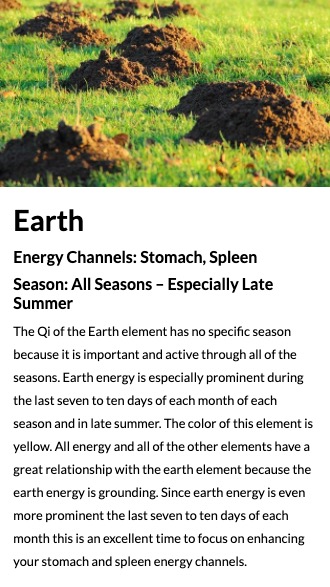
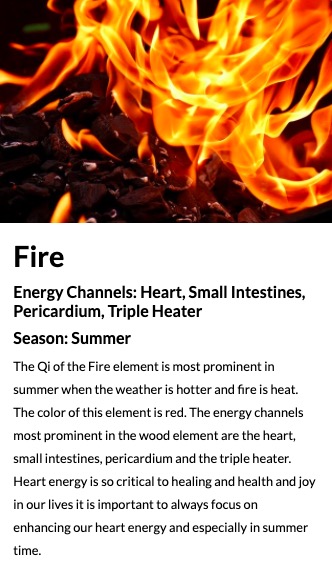
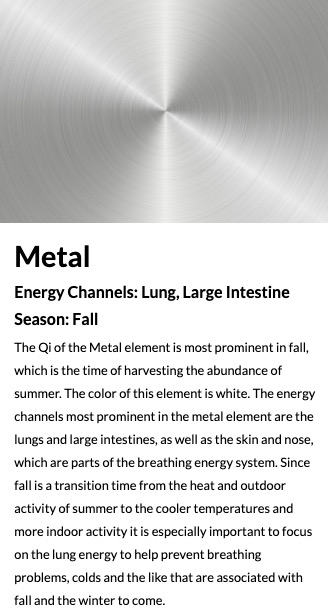
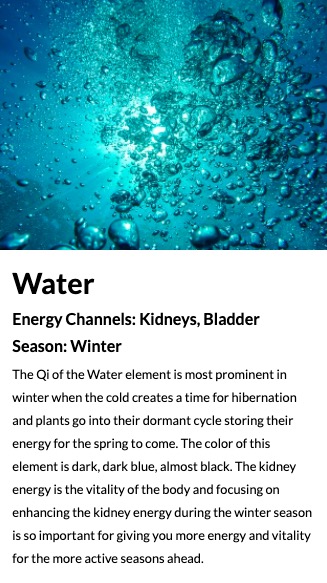
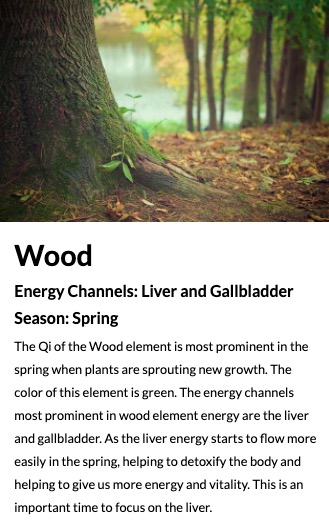
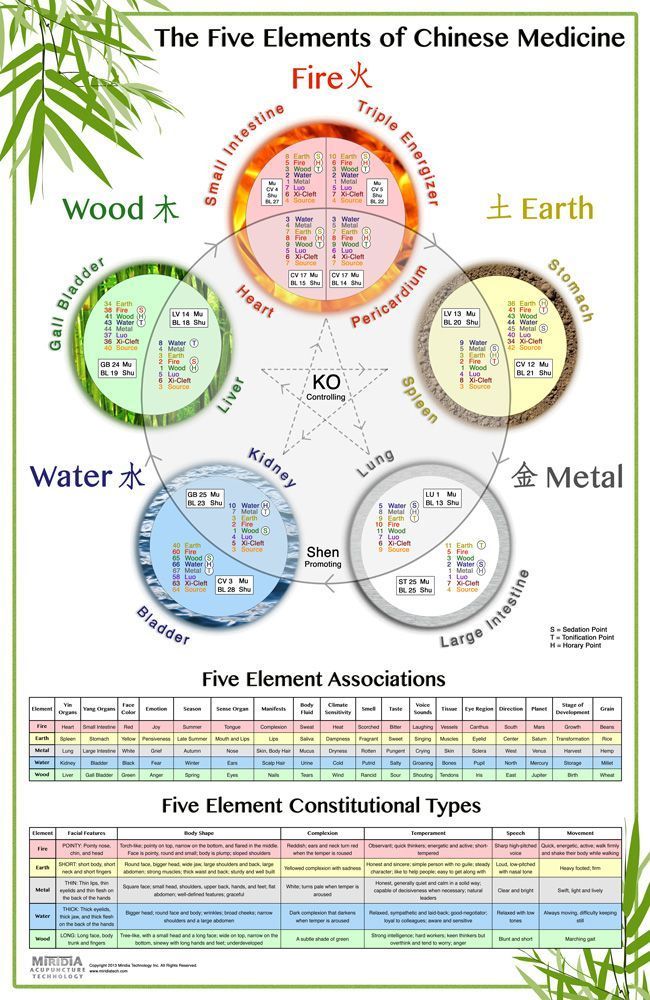
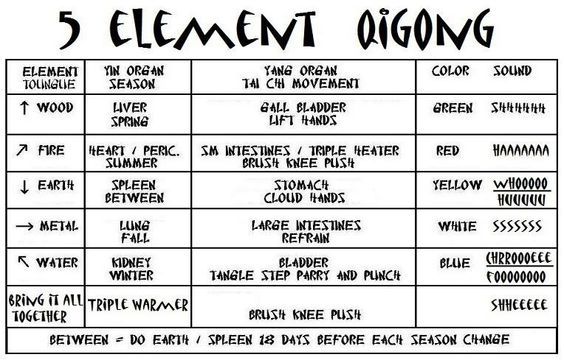
Historic Tao Yin Parchment
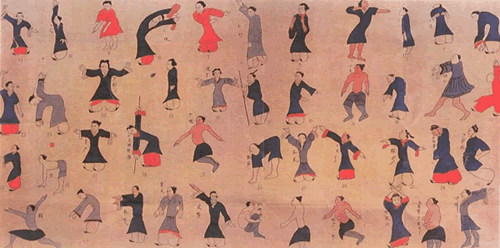
“Breathing in and out in various manners, spitting out the old and taking in the new, walking like a bear and stretching their neck like a bird to achieve longevity – this is what such practitioners of Daoyin, cultivators of the body and all those searching for long enjoy.”
– Chuang-tzu, circa 300 BCE.
There was a feudal lord, the Marquis of Dai (King Ma), who lived around 160 BCE during the Western Han Dynasty. When the Marquis of Dai, his wife, and his son died, there were many objects placed in their family tomb as part of funeral rites and customs. In 1973, archeologists in China excavated the family tomb of the Dai family on the outskirts of the city of Changsha in Hunan Province. In the son’s tomb they discovered a lacquered box containing medical manuals, documents, and a silk scroll on which were drawn 44 humans in various poses or postures. Under each pose was a caption with the name of an animal or the name of a disease that the posture might help prevent or cure. The chart or diagram (Tu) on this scroll shows Daoyin (Guiding/Leading Energy and Stretching/Pulling Out) exercises or poses. A number of the postures shown on this Daoyin Tu closely resemble some in the Eight Section Brocade and in the Five Animal Frolics (i.e., the bear, monkey, and bird).
Hua Tuo’s life ended at age 97 in an unfortunate manner. He had been called and ordered to serve as a personal physician to Zao Cao, a ruthless general ruling the state of Wei. Zao Cao had severe headaches which Dr. Hua Tuo could not cure. General Zao Cao, for some unknown reason, became angry with Dr. Hua Tuo, and had him imprisoned and executed. (
One of Hua Tuo’s outstanding disciples, Wu Pu, lived for over 100 years, and practiced the Frolics daily. Wu Pu wrote a book called The Five Animal Classic, from which only a few fragments have survived. Wu Pu reported that Hua Tuo once said,
“Man’s body must have exercise, but it should never be done to the point of exhaustion. By moving about briskly, digestion is improved, the blood vessels are opened, and illnesses are prevented. It is like a used doorstep which never rots. As far as Tao Yin (bending and stretching exercises) is concerned, we have the bear’s neck, the crane’s twist, and swaying the waist and moving the joints to promote long life. Now I have created the art called the Frolics of the Five Animals: the Tiger, the Deer, the Bear, the Monkey, and the Crane. It eliminates sickness, benefits the legs, and is also a form of Tao Yin. If you feel out of sorts, just practice one of my Frolics. A gentle sweat will exude, the complexion will become rosy; the body will feel light and you will want to eat.”
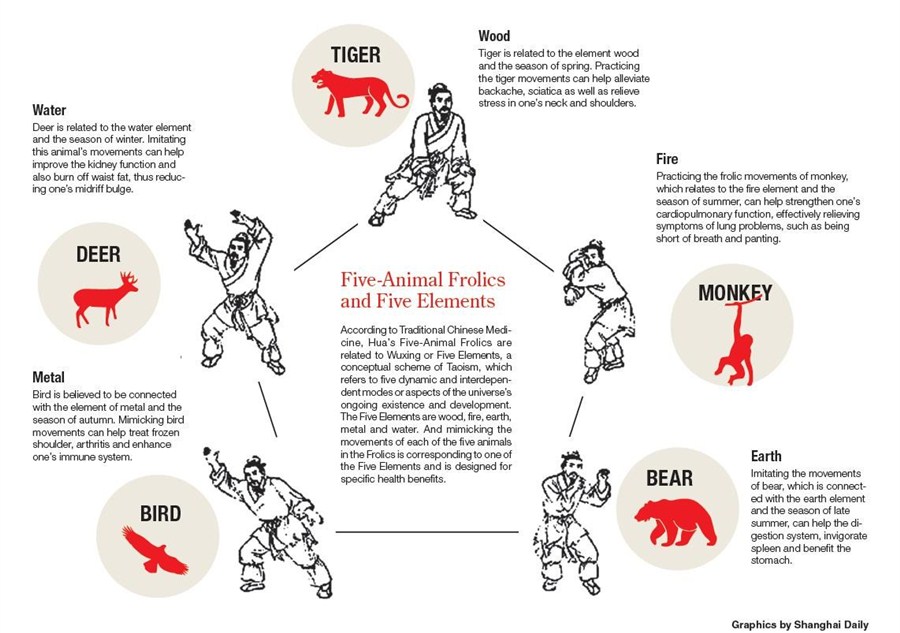
Ba Duan Jin “Eight Pieces of Brocade” Qigong Set
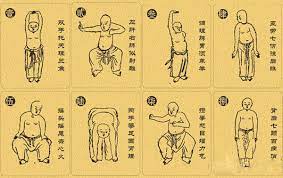
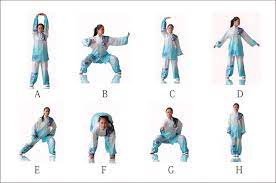
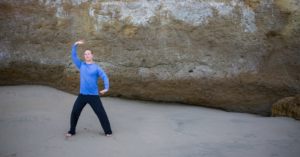
Many things have changed since the early beginnings of Qi Gong. Even within our lifetimes, our world has seen significant transformations in every aspect: technologically, socially, culturally, and even spiritually. However, despite the rapid evolution of humankind, there are some things that remain timeless. One of these is the wisdom that Qi Gong can teach us.
While the specific intentions of early Qi Gong practitioners were sometimes different than ours in the twenty-first century, we can still apply their knowledge in our modern lives. After all, our DNA has stayed pretty consistent for thousands of years. One of the things that Lee loves about Qi Gong is how it allows us to use ancient wisdom for modern purposes. Today, we’re going to explore the history of the Eight Pieces of the Silk Brocade, as well as how the practice can be applied today.
Born on the Battlefield
As a practice for strength and vitality, it’s no surprise that warriors were some of the first Qi Gong practitioners. Anything that could allow soldiers to cultivate power was seen as valuable, so many generals studied and taught various Qi Gong practices.
The practice known as Eight Pieces of the Silk Brocade originated during the South Song Dynasty nearly 1000 years ago. As legend has it, a young Chinese General named Yue Fei decided to commit himself to discover more ways to enhance the strength of his army. He was already well known as an excellent general and skilled martial artist, but he knew there was more to power than strategy and physical strength.
To explore his own inner power, General Yue Fei started studying history as well as Chinese classics about Qi Gong. At the time, there were already nearly 3000 years worth of Qi Gong evolution, so he has a lot of guidance. By combining ancient wisdom with his “modern” understanding of combat, he was able to develop a new practice that was extremely effective for both himself and his soldiers. He created practices for able-bodied soldiers as well as for the wounded. Some of the practices were actually specifically designed for those who couldn’t walk.
The new practices were invaluable for the Chinese army as they defended themselves against the Mongolian invasion. Combined with rigorous military training, General Yue Fei’s soldiers became formidable opponents on the battlefield. They also experienced greater health at home.
As more people started learning about the Eight Pieces of the Silk Brocade, it became popular among the civilian population as well. Not only did the practice give people greater physical strength, but it also increased their focus, resiliency, and internal peace.
Fundamentals of the Practice
The Eight Pieces of the Silk Brocade offers practices that are accessible for everyone, regardless of age or physical condition. In general, the first practices that students generally learn about are relaxation.
Many ailments that people experience are the result of stress or tension that leads to stagnation within the body. When our body becomes stagnant, our emotions and Qi are no longer able to circulate in a healthy and positive way. On the other hand, when your body is relaxed, your Qi can flow smoothly and all parts of your body are able to find harmony with one another.
By learning how to identify stress and tension, practitioners can begin to release it through exercises taught in Eight Pieces of the Silk Brocade. Additionally, they can learn how to balance energies that may have gotten out of harmony with one another within the body.
Like many practices, the Eight Pieces of the Silk Brocade was often communicated in poetry form. This reminds us that it isn’t just about learning the specific routines, but also about practicing them in a way that helps us find flow with ourselves and the world. Just like spoken poetry, the Eight Pieces of the Silk Brocade is based on finding a graceful and fluid rhythm among your own internal energies.
Part of finding this internal harmony relies on cultivating awareness of various energies within. Once you’ve learned a variety of practices and are able to really tap in with what’s happening inside, you can allow your own needs to guide your practice as your own personal dance.
While ancient Chinese soldiers were focused on cultivating personal power for the battlefield, the practices are equally valuable for cultivating personal power in all ways. The same principles of redirecting adversarial energy from an opponent in battle can also apply to redirect negative energy in a stressful situation. Instead of facing the threat of a sharp sword, perhaps you encounter angry children or toxic ways of speaking. In such situations, the practices and techniques of the Eight Pieces of the Silk Brocade are an excellent way to protect yourself while maintaining your peace of mind.
The Eight Pieces of the Silk Brocade is similar to many of Lee’s other practices while also offering a unique flavor. It provides a new approach to addressing the energies that Lee already teaches about and invites students to examine their personal awareness with a new lens. The practices work with both the mind and body, and pays special attention to the intentions we bring to our life.
Many thanks to Holden Qigong for the above information.